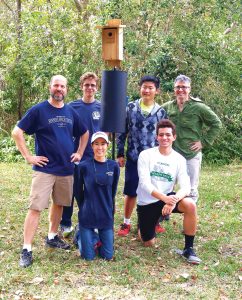School club hopes to lure bluebirds with nesting boxes

Kneeling, Grace Igel and Nick McIntyre; standing: Bolles environmental club advisor Andrew Dickson, Wyatt Kogan, Henry Li and Brett Moyer, honors environmental science teacher.
The bluebird population in San Marco and elsewhere in Jacksonville might be on the rise this spring.
In December, students from The Bolles School installed nesting boxes in Alexandria Oaks Park and River Oaks Park in San Marco, and on the school’s Ponte Vedra and Bartram campuses.
Bluebirds are easy to spot. The males are bright blue with orange breasts. The females are a little grayer. They eat insects and berries, not birdseed, but they will visit birdbaths.
It is the second phase of a project that Dr. Brett Moyer started last year on the San Jose campus with the help of a grant from the Florida Bluebird Society.
Three pairs of bluebirds took up residence and each produced three broods, so Moyer decided to expand the project this year and include students from his honors environmental science class.
Bluebirds should start prospecting for a nesting box in January and begin laying eggs in late February or March, Moyer said. Last year the last fledgling left in July.
The students and community volunteers will monitor the boxes weekly, watching for signs of nest building and for signs of trouble.
Though the Eastern bluebird is not endangered, its numbers have dropped dramatically since the 1800s when they flocked by the hundreds to feed in farmers’ fields, said Joanne Heinrich, Duval County coordinator of the Florida Bluebird Society.
Several factors have contributed to the decline: Loss of habitat because of development, and competition from European starlings and house sparrows.
“Bluebirds are cavity nesters but they are not capable of excavating their own cavities so they depend on woodpecker holes for their nests,” Heinrich said. “Woodpeckers need dead trees for their nests. We tend to clear the land and nowadays nobody leaves up a dead tree. So the bluebird’s primary problem is habitat loss and degradation. They can’t find a place to build their nests.”
The more aggressive European starlings and house sparrows will take over a bluebird nest, even one with hatchlings. And then there are predators — raccoons, snakes, cats and fire ants.
Since bluebirds eat insects, pesticides present a problem, too.
“People cause their problems, people can solve their problems,” Heinrich said. “We can provide them with safe places to nest.”
But not any birdhouse will do.
Bluebird boxes need an entrance that is 1.5 inches wide to keep out larger birds. Boxes need to be erected on a pole with a raccoon baffle to keep predators at bay. Bluebirds prefer nests in open areas with some shade.
“Part of the reason I chose to focus on bluebirds is that they are quite tolerant of human activity,” Moyer said. “If you put up a box, they will reliably nest in a way where people can enjoy them.”
Moyer is looking for volunteers in San Marco to help monitor the boxes from March through July. Contact him at [email protected].
For more information about bluebirds, go to www.floridabluebirdsociety.com.
By Lilla Ross
Resident Community News






